Al Fahidi Historical Neighbourhood stands as a testament to Dubai’s rich cultural heritage and traditional Emirati lifestyle. Also known as Al Bastakiya, this meticulously preserved district offers visitors a rare glimpse into pre-oil Dubai, showcasing authentic Arabian architecture and the city’s transformation from a humble fishing village to a global metropolis.
Whether you’re a history enthusiast, architecture lover, or simply seeking an escape from Dubai’s modern skyline, Al Fahidi Historical Neighbourhood provides an immersive cultural experience that transports you back to the 19th century.
What is Al Fahidi Historical Neighbourhood?
Al Fahidi Historical Neighbourhood is Dubai’s oldest heritage district, dating back to the 1890s. This carefully restored quarter once housed up to 60 residential units and served as home to wealthy Persian merchants who migrated across the Arabian Gulf from the Bastak region of southern Iran—hence its original name, Al Bastakiya.
The neighbourhood represents traditional Dubai life from the mid-19th century through the 1970s, before the oil boom transformed the emirate into the modern metropolis it is today.
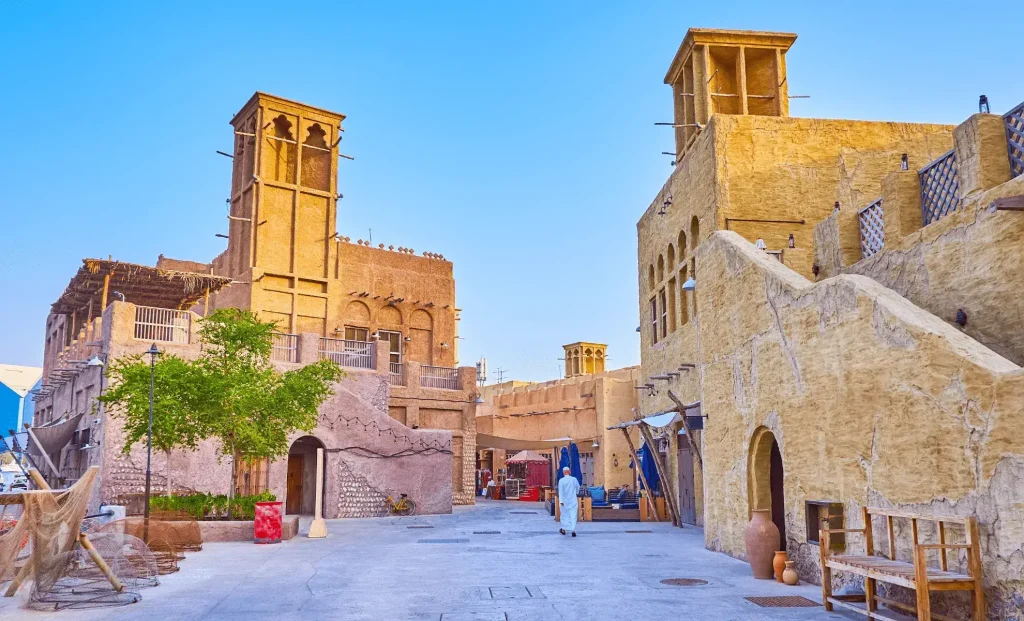
Architectural Highlights: Traditional Wind Towers and Courtyard Houses
The Iconic Wind Towers (Barjeel)
The most distinctive architectural feature of Al Fahidi is its traditional wind towers, locally known as “barjeel.” These ingenious structures served as ancient air conditioning systems, capturing cool breezes from above and channeling them down into living spaces below. The wind towers stand as symbols of traditional Emirati architectural innovation and adaptation to the harsh desert climate.
Traditional Construction Materials
The buildings in Al Fahidi showcase authentic Arabian construction techniques using:
- Coral stone from the Arabian Gulf
- Gypsum for decorative elements
- Teak and sandalwood for doors and windows
- Palm wood for roofing structures
- Traditional lime plaster for walls
These materials not only provided excellent insulation against Dubai’s intense heat but also created the distinctive aesthetic that defines the neighbourhood today.
Courtyard Design
The houses feature inward-facing courtyards that offered privacy for families while providing natural ventilation and shaded outdoor spaces—essential elements of traditional Gulf architecture.
Top Attractions in Al Fahidi Historical Neighbourhood
1. Dubai Museum at Al Fahidi Fort
Location: Inside Al Fahidi Fort (built 1787)
Opening Hours: 8:30 AM – 8:30 PM (Saturday-Thursday), Friday hours vary
Entry Fee: AED 3-10
Dubai Museum, housed within the historic Al Fahidi Fort, is the emirate’s premier cultural institution. The museum features underground galleries showcasing:
- Traditional Emirati life and customs
- Maritime heritage and pearl diving history
- Ancient weaponry and artifacts
- Life-size dioramas depicting historical Dubai scenes
- Archaeological discoveries from the region
2. Coffee Museum
The Coffee Museum celebrates Arabia’s deep-rooted coffee culture, displaying:
- Antique coffee-making equipment from around the world
- The history of coffee trade in the Arabian Peninsula
- Traditional Arabic coffee ceremonies
- Vintage coffee grinders and roasters
Visitors can sample authentic Arabic coffee (gahwa) and learn about the beverage’s significance in Emirati hospitality.
3. Coin Museum
This specialized museum showcases:
- Historical currency used in Dubai and the UAE
- Evolution of monetary systems in the region
- Rare coins from Islamic civilizations
- Traditional trade and commerce practices
4. Sheikh Mohammed Centre for Cultural Understanding (SMCCU)
Programs Offered:
- Cultural breakfast experiences
- Traditional Emirati meals
- Guided heritage tours
- Arabic language sessions
- Open discussions about Emirati culture and Islam
The SMCCU promotes cross-cultural dialogue and offers visitors authentic insights into Emirati traditions, customs, and daily life.
5. Art Galleries and Cultural Spaces
Al Fahidi has evolved into Dubai’s artistic hub, featuring:
- XVA Gallery: Contemporary Middle Eastern art
- Majlis Gallery: One of Dubai’s oldest art galleries
- Alserkal Cultural Foundation: Cultural programs and exhibitions
- Multiple independent artist studios and exhibition spaces
6. Traditional Souk Shopping
Explore nearby traditional markets:
- Textile Souk: Colorful fabrics, traditional garments, and materials
- Spice Souk: Aromatic spices, herbs, and traditional ingredients
- Gold Souk: Just across Dubai Creek, featuring world-famous gold jewelry
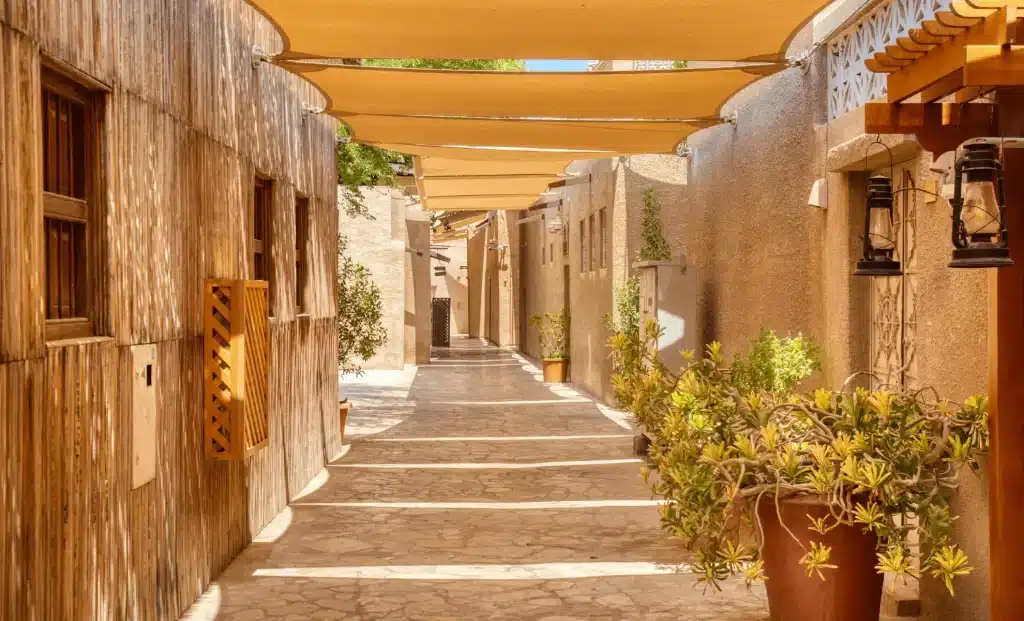
Things to Do in Al Fahidi
Walking Tours
Join guided walking tours led by local Emirati guides who share personal stories and historical insights about the neighbourhood’s evolution. Tours typically last 1-2 hours and cover major landmarks, hidden courtyards, and architectural details.
Photography Opportunities
The narrow alleyways, traditional doors, wind towers, and honey-colored walls create countless Instagram-worthy moments. Best photography times are early morning (7-9 AM) or late afternoon (4-6 PM) when the light enhances the texture of the traditional buildings.
Cultural Workshops
Participate in traditional activities:
- Arabic calligraphy classes
- Henna art sessions
- Traditional pottery demonstrations
- Emirati cooking classes
- Pearl diving history talks
Dining Experiences
Enjoy authentic Middle Eastern cuisine at:
- Arabian Tea House: Traditional Emirati dishes and refreshing beverages
- XVA Café: Vegetarian and organic Middle Eastern cuisine
- Several small cafés offering Arabic coffee, dates, and traditional sweets
Practical Visitor Information
Location and Address
Address: Al Fahidi Street, Bur Dubai, Dubai, United Arab Emirates
Coordinates: 25.2631° N, 55.2972° E
District: Bur Dubai (near Dubai Creek)
Opening Hours
- Neighbourhood Access: Open 24/7 (free entry)
- Museums: Generally 9:00 AM – 6:00 PM (varies by institution)
- Galleries: Typically 10:00 AM – 6:00 PM (closed Fridays or Mondays)
- Cafés and Restaurants: 8:00 AM – 10:00 PM
Entry Fees
- Walking through the neighbourhood: FREE
- Dubai Museum: AED 3-10
- Most other museums: AED 3-10
- Gallery exhibitions: Usually FREE
- Guided tours: AED 50-150 depending on experience
Best Time to Visit
Seasonal Timing:
- October to April: Ideal weather (20-30°C), perfect for exploring
- May to September: Very hot (35-45°C), visit early morning or evening
Daily Timing:
- Early Morning (7-10 AM): Cooler temperatures, fewer crowds, best natural light
- Late Afternoon (4-7 PM): Pleasant evening ambiance, cafés come alive
- Avoid midday (12-3 PM): Intense heat, many attractions closed for lunch
Recommended Visit Duration
- Quick visit: 1-2 hours (main walkthrough and photo stops)
- Standard visit: 2-4 hours (including 1-2 museums and café break)
- Comprehensive visit: Half day to full day (all museums, galleries, dining, and shopping)
How to Get to Al Fahidi Historical Neighbourhood
By Metro
Nearest Station: Al Fahidi Metro Station (Green Line)
Walking Distance: 5-7 minutes from metro exit
Cost: AED 3-8 depending on zones
Exit the station and follow the signs toward Al Fahidi Historical Neighbourhood. The walk is straightforward and well-signposted.
By Bus
Nearby Bus Routes: Multiple routes stop at Al Fahidi Bus Station
Routes: 8, 20, 29, 42, 44, C5, C10, C18, C28
Cost: AED 3-5 per journey
By Taxi or Ride-Share
- From Dubai Marina: 25-30 minutes (AED 35-50)
- From Downtown Dubai: 15-20 minutes (AED 25-35)
- From Dubai International Airport: 15-20 minutes (AED 30-45)
Popular ride-sharing apps: Uber, Careem, Hala Taxi
By Car
Parking: Free parking available in designated areas near the neighbourhood
GPS Coordinates: Use “Al Fahidi Historical Neighbourhood” in navigation apps
Driving Tips: Traffic can be heavy during peak hours (8-9 AM, 5-7 PM)
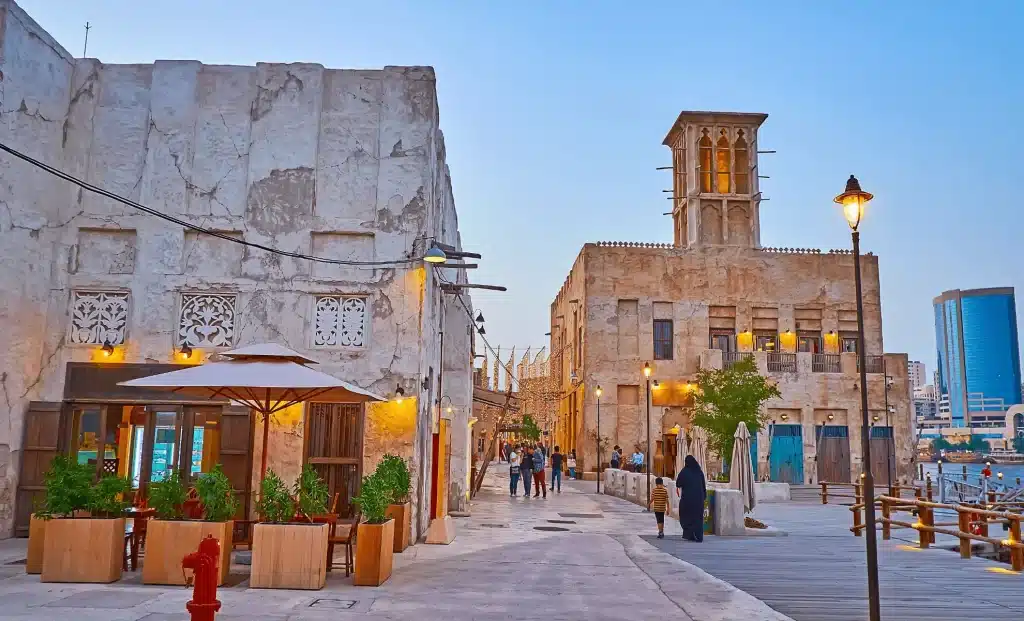
Al Fahidi Historical Neighbourhood Map and Layout
The neighbourhood is compact and easily walkable, covering approximately 38,000 square meters. Key areas include:
- Northern Section: Main entrance from Al Fahidi Metro Station
- Central Area: Courtyard houses, galleries, and cafés
- Eastern Side: Adjacent to Dubai Creek and textile markets
- Western Section: Connects to Al Fahidi Fort and Dubai Museum
History of Al Fahidi: From Trading Hub to Cultural Icon
The Founding Years (1890s)
Al Fahidi was established in the late 19th century when Persian merchants from Bastak settled in Dubai, attracted by tax incentives offered by Sheikh Maktoum bin Hasher Al Maktoum. These merchants established the neighbourhood as a residential and trading district strategically positioned along Dubai Creek.
The Golden Era (1900s-1960s)
During this period, Al Fahidi thrived as:
- A residential area for wealthy pearl merchants and traders
- A center for textile and spice trade
- A hub connecting Dubai Creek’s maritime activities
- Home to influential families shaping Dubai’s commerce
Decline and Near-Demolition (1970s-1980s)
As Dubai modernized after oil discovery, many historical areas faced demolition. Al Fahidi nearly met the same fate, with residents relocating to modern neighborhoods. By the 1980s, the district had fallen into disrepair.
Restoration and Revival (1990s-Present)
Under the vision of Dubai’s leadership, particularly through the Dubai Municipality and later Dubai Culture & Arts Authority, Al Fahidi underwent extensive restoration:
- 1995: Restoration project began
- 2005: Opened as heritage district
- 2009: Major conservation completed
- Present: Ongoing preservation and cultural programming
What Makes Al Fahidi Special?
Authenticity in Modern Dubai
In a city defined by futuristic skyscrapers and luxury developments, Al Fahidi offers authentic cultural immersion. The neighbourhood hasn’t been artificially recreated—it’s been carefully preserved and restored using traditional techniques.
Living Heritage
Unlike museum exhibits, Al Fahidi is a living, breathing community where art galleries operate in century-old buildings, cafés serve traditional recipes, and cultural centers continue Emirati traditions.
Educational Value
The neighbourhood serves as an open-air classroom teaching:
- Traditional Gulf architecture and engineering
- Pre-oil Emirati lifestyle and social structures
- Pearl diving and maritime heritage
- Islamic art and calligraphy
- Cross-cultural influences between Persia and Arabia
Peaceful Atmosphere
The pedestrian-only narrow lanes create a tranquil oasis away from Dubai’s busy highways, offering shade, quiet, and contemplative spaces.
Tips for Visiting Al Fahidi Historical Neighbourhood
Dress Code
- Respectful attire recommended: Cover shoulders and knees
- Comfortable walking shoes: Cobblestone paths and uneven surfaces
- Sun protection: Hat, sunglasses, and sunscreen
- Layered clothing: For air-conditioned indoor spaces
What to Bring
- Camera or smartphone for photography
- Reusable water bottle (stay hydrated)
- Cash for small museums and cafés (though cards widely accepted)
- Light backpack for purchases from souks
Photography Etiquette
- Photography is generally permitted in outdoor areas
- Ask permission before photographing people
- Some museums prohibit flash photography
- Respect “No Photography” signs in sacred or private spaces
Combine with Nearby Attractions
Create a full day by visiting:
- Dubai Creek: Traditional abra (water taxi) rides (AED 1)
- Gold Souk: World-famous gold market
- Spice Souk: Aromatic traditional market
- Heritage Village: Another restored traditional area
- Al Seef: Modern waterfront development with heritage architecture
Events and Cultural Activities
Seasonal Festivals
- Sikka Art Fair (March): Annual contemporary art festival
- Al Fahidi Festival (Various): Cultural performances and exhibitions
- Ramadan Programs: Special cultural events and iftars
- UAE National Day (December 2): Heritage celebrations
Regular Programming
- Weekly cultural talks at SMCCU
- Monthly art exhibitions at galleries
- Traditional music performances
- Heritage craft demonstrations
Accommodation Near Al Fahidi
Heritage Hotels Within the District
- XVA Art Hotel: Boutique heritage hotel within restored traditional house
- Orient Guest House: Intimate stay in converted courtyard home
Nearby Hotels (Walking Distance)
- Four Points by Sheraton Bur Dubai
- Arabian Courtyard Hotel & Spa
- Hyatt Place Dubai Al Rigga
- Numerous budget and mid-range options in Bur Dubai
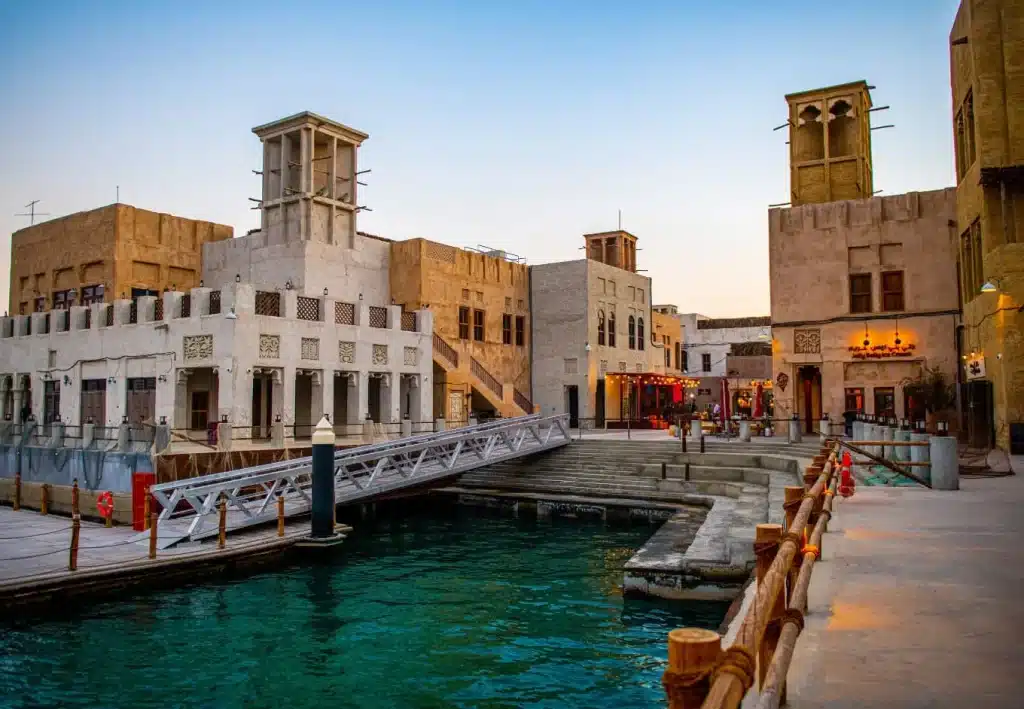
Al Fahidi for Different Types of Travelers
For Families with Children
- Educational experience about Dubai’s history
- Child-friendly walking paths
- Interactive museum exhibits at Dubai Museum
- Ice cream and snack options at cafés
- Short, manageable exploration time
For Solo Travelers
- Safe, pedestrian-friendly environment
- Photography opportunities
- Cultural learning experiences
- Quiet cafés for reflection and journaling
- Easy to navigate independently
For Couples
- Romantic alleyways and hidden courtyards
- Intimate dining experiences
- Sunset photography sessions
- Cultural date activities
- Peaceful escape from city crowds
For Art Enthusiasts
- Multiple contemporary art galleries
- Traditional Islamic art displays
- Artist studios and workshops
- Quarterly art exhibitions and openings
- Opportunities to meet local and regional artists
Sustainability and Preservation Efforts
Dubai Culture & Arts Authority implements rigorous preservation standards:
- Using traditional building materials and techniques
- Maintaining original architectural features
- Sustainable tourism practices
- Cultural education programs
- Community engagement initiatives
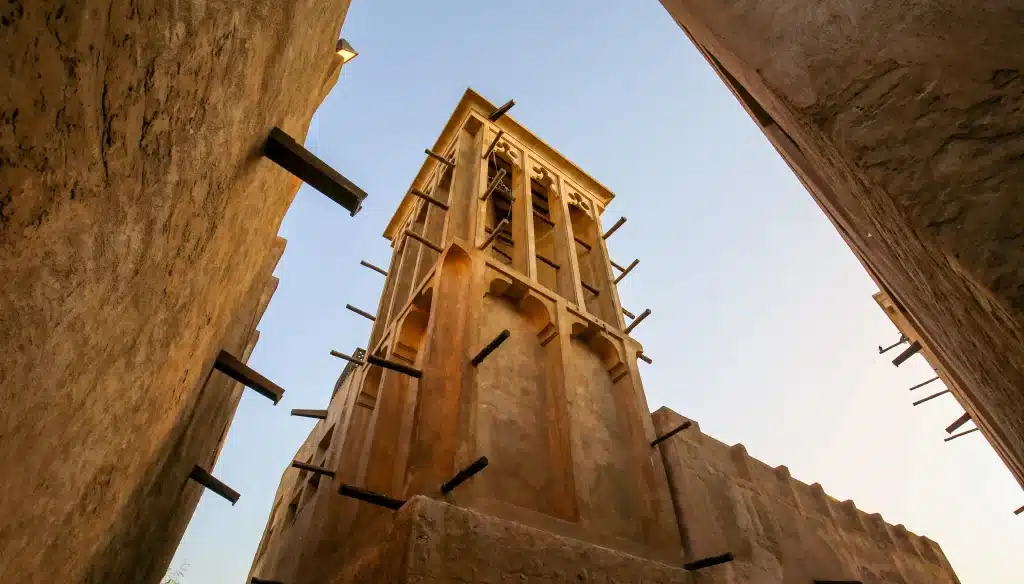
Frequently Asked Questions
Is Al Fahidi Historical Neighbourhood worth visiting?
Absolutely. It offers authentic cultural experiences, beautiful architecture, and peaceful atmosphere contrasting with modern Dubai.
How long should I spend at Al Fahidi?
2-4 hours is ideal for most visitors, though art lovers and history enthusiasts may want a full day.
Is there an entrance fee?
Walking through the neighbourhood is free. Individual museums charge AED 3-10.
Can I visit during Ramadan?
Yes, but restaurant hours may be limited during fasting hours. It’s an excellent time to experience Ramadan cultural programs.
Is it wheelchair accessible?
Most areas have uneven surfaces and steps. Some museums and cafés have accessibility features, but full access is limited.
Are there toilets available?
Yes, public restrooms are available at museums, cafés, and cultural centers.
Can I hire a guide?
Yes, certified guides are available through SMCCU and various tour operators.
Conclusion: Why Visit Al Fahidi Historical Neighbourhood
Al Fahidi Historical Neighbourhood represents Dubai’s soul—a reminder of the emirate’s humble origins, cultural roots, and architectural heritage. In a city often associated with superlatives and modernity, this preserved quarter offers something irreplaceable: authenticity.
Whether you’re photographing wind towers at golden hour, sipping Arabic coffee in a traditional courtyard, exploring contemporary art in century-old buildings, or learning about pearl diving heritage, Al Fahidi provides experiences that connect you to real Emirati culture and history.
For visitors seeking to understand Dubai beyond its glittering skyline, Al Fahidi Historical Neighbourhood is not just recommended—it’s essential. This living heritage district proves that in Dubai’s rush toward the future, its past remains carefully honored, preserved, and celebrated.

